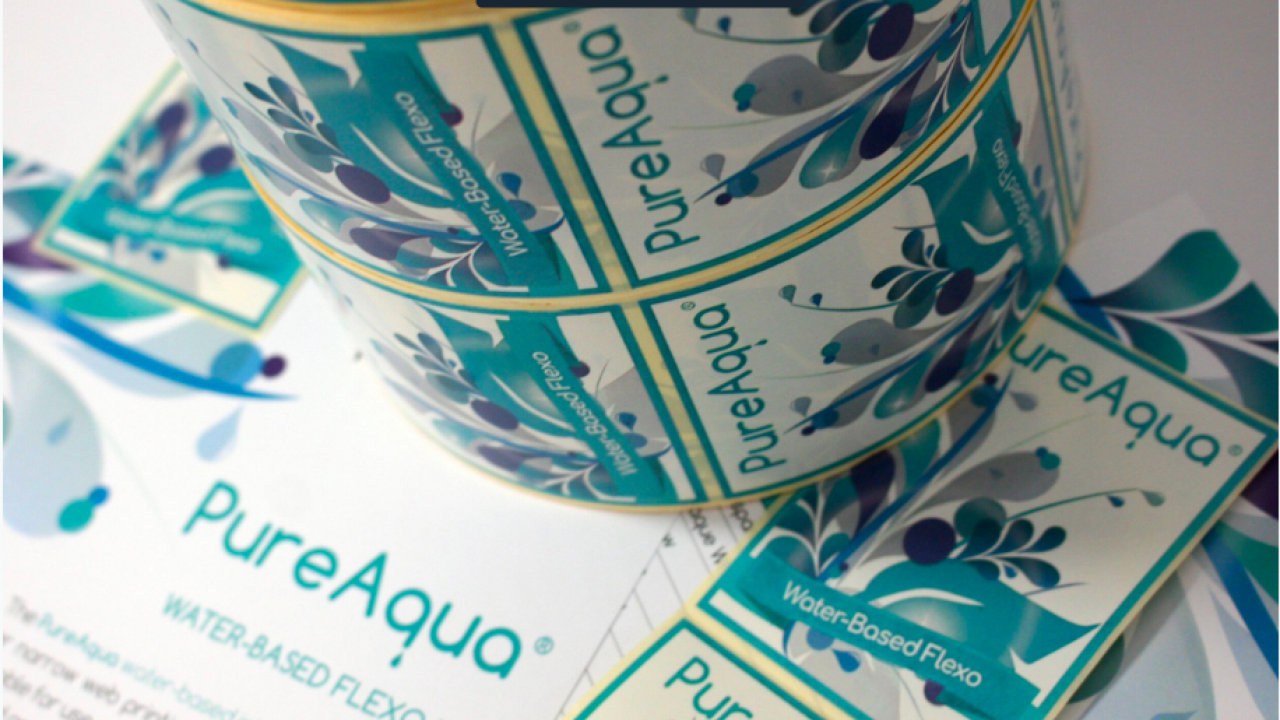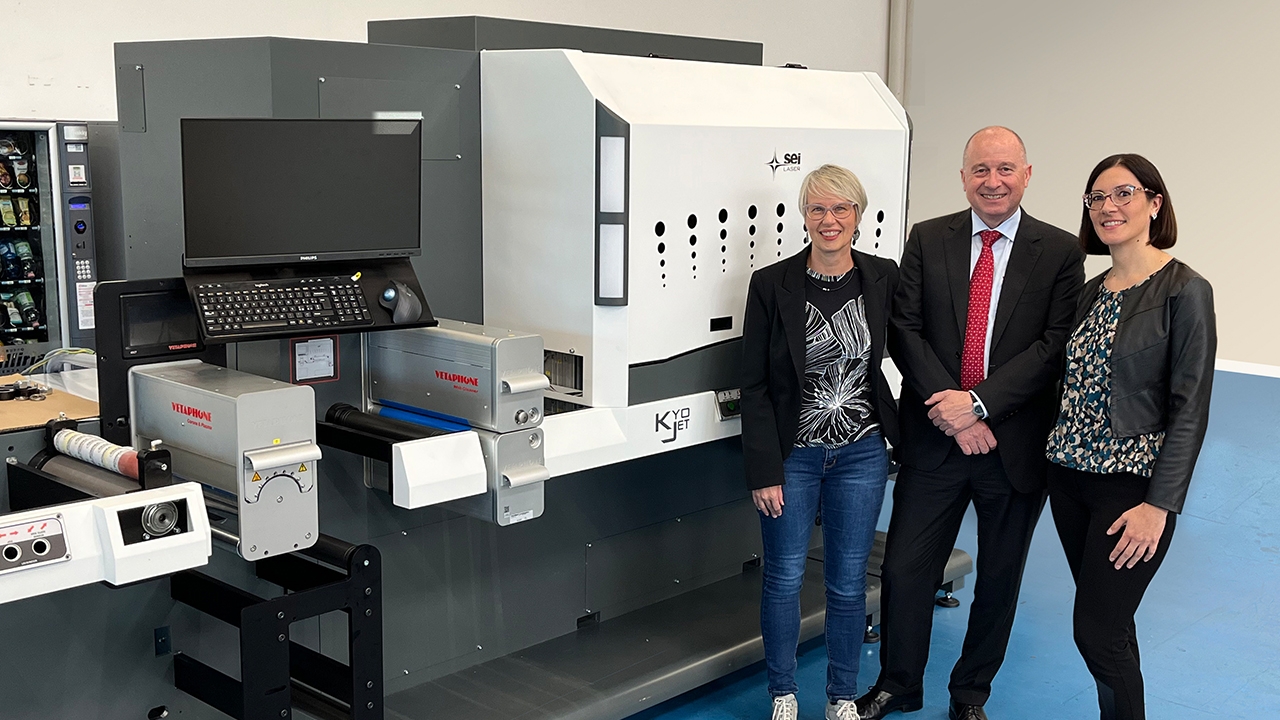The perfect mix

From printing and post-press processing to the application and ambient environment, there are a number of factors that converters must consider when making their ink selection. Suppliers must similarly be aware of these factors when developing new ink formulations.
Water-based
This has lead Pulse Roll Label Products to develop PureAqua, a water-based flexo ink system comprising a 4-color process set and mixing bases. A PureAqua color matching database, using X-Rite’s InkFormulation software, provides accurate color matching. Mikaela Harding, product manager, explains: ‘Although the majority of our business is UV flexo, many of our customers also use water-based flexo technology for printing on multiple substrates. We understand the need for color consistency on a global scale and the value of digital color management as proved with our PureTone UV flexo ink system. We wanted to be able to offer a single ink system that could achieve the highest level of color consistency and print quality for water-based flexo, and on all substrates. Our high-strength PureAqua ink system builds on the concept of offering a total color management solution and is unique in the label market in that it’s formulated for use on coated and uncoated papers, thermal papers and films.’
Sato UK is an example of such a scenario outlined by Harding. PureTone inks were already in use at its Harwich site. PureAqua is now in use there too. Martin Clackett, print production manager at the Sato UK site in Harwich, says: ‘We made the move to PureAqua to support our drive to achieve the highest quality of water-based flexo printing on both standard and thermal papers. The PureAqua ink system means that we need to use only one ink system for both substrates making it more efficient and cost-effective, whilst at the same time providing optimal print performance and accurate color to satisfy our water-based flexo requirements. Combined with the PureAqua varnishes that we also run, we have a complete water-based flexo solution to complement our whole UK labeling business.’
Digital
HP’s developments focus on ElectroInk to work with its liquid electrophotography (LEP) technology. HP ElectroInk contains charged pigmented particles in a liquid carrier, combining the advantages of electronic printing with the qualities of liquid ink. On-press, ElectroInk is supplied as a concentrated paste that is loaded into the press in tubular cartridges in a ‘clean hands’ operation. Inside the press it is fed into ink supply tanks and diluted with oil, to form a fluid mixture of carrier liquid and colorant particles ready for printing.
This core formula is replicated across the ElectroInk portfolio, regardless of ink type or application. Thanks to this, the characteristics of the ink are not dependent on the pigment and the behavior through the printing process remains similar across all inks.
Nurit Carmel-Barnea, who oversees the market development of new HP Indigo ElectroInk products, explains: ‘This gives ElectroInk the inherent capability to carry a wide range of pigments to produce different inks for endless possibilities. All that is needed to create a new ink is to change recipe with the pigment, which can be white, fluorescent or UV.’
HP Indigo is now building a portfolio of special inks beyond the CMYK and OVG ink set, with more than 20 special ink types available today in addition to the wide variety of available spot inks. Spot inks can reach up to 97 percent of Pantone colors to match a specific customer color or brand request. The brand color formula is developed, saved and secured by HP to ensure a consistent color. Coca-Cola, for instance, went through a process to qualify Coke Red, notes Carmel-Barnea.
New families of inks are developed to target new markets for digital printing, such as yellow and blue inks for the security market and fade resistant inks for the agrochem market. With new inks, HP Indigo customers can diversify and grow their business, including expanding into all-new applications such as security printing with variable data in invisible ink.
Geostick Group recently adopted HP Indigo ElectroInk Premium White and Silver ElectroInk on its HP Indigo digital presses. This includes an HP Indigo 20000 and WS6000 series digital presses.
Cees Schouten, operations director at Geostick Group, says his company is benefitting from higher productivity and throughput using Premium White, which is used across all of its label production, but especially for the household decorative coating industry. ‘This delivers a high opacity white as a backing for brand colors delivering higher output per hour thanks to fewer ink separations,’ says Schouten.
‘Premium White has now become our standard,’ he continues. ‘It is enabling us to move more print jobs to digital from flexo thanks to these new technical possibilities, including on clear substrates.’
Geostick is reporting success with ElectroInk Silver, enabling printing on regular white stock for saving up to 35 percent on metallized substrates. The ink is used heavily for automotive industry labels, delivering the same quality as flexo printing. US-based Innovative Labeling Solutions (ILS) beta-tested HP Indigo ElectroInk Silver and is now offering the ink to its brands. ‘Eye-catching metallic designs can be achieved while maintaining the benefits of digital printing, including easily and cost effectively changing the metallic effect from version to version,’ says Kristen Waite, marketing communications manager at ILS.
ILS is printing silver ink on clear BOPP and its customers are finding it to be a viable, economical alternative to using a hot stamp when trying to achieve custom metallic designs for different versions and label sizes in a product line. Waite adds: ‘By using silver ink, they avoided the upfront tooling costs they would have incurred for each design and each label size.’
Another US-based converter now deploying ElectroInk Silver is Precision Label Corporation. It serves major cosmetic brands. ‘We are getting excellent results printing fine type and vignettes in silver and can produce virtually any metallic color by printing process colors over the silver,’ said Angelo Quagliata, vice president sales at Precision Label. ‘Digitally printed silver ink is a big plus for our customers who want digital printing benefits without compromising on metallic effects, especially cosmetics companies that need a higher-end look.’
Security
Nosco, a Chicago-based printer that specializes in printed packaging for the natural health, personal care and pharmaceutical industries, is reaping similar rewards, but with ElectroInk Invisible Yellow and the Security ElectroInk 523 infrared ink. Nosco has now dedicated a production line featuring an HP Indigo WS6600 digital press to print security elements for 30-plus customers, including overt barcodes, microprint and other technologies.
Craig Curran, senior vice president of sales and marketing at Nosco, says: ‘Brand owners in the healthcare market are especially in need of covert print security solutions. Through the use of invisible technologies like these, we can help our customers combat the growing threat of product diversion.’
ILS is also rolling out HP Indigo ElectroInk Invisible Yellow and Blue security inks, which are only visible under UV light. ‘Counterfeit and fraudulent goods continue to be a major concern for brands of all sizes. Considering the vital role labels and packaging play in combatting counterfeit products, invisible ink offers a valuable tool for helping ensure brand protection and integrity across the supply chain,’ concludes Waite.
Stay up to date
Subscribe to the free Label News newsletter and receive the latest content every week. We'll never share your email address.


